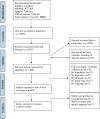Social inequities in vaccination coverage among infants and pre-school children in Europe and Australia - a systematic review
- PMID: 30866881
- PMCID: PMC6417277
- DOI: 10.1186/s12889-019-6597-4
Social inequities in vaccination coverage among infants and pre-school children in Europe and Australia - a systematic review
Abstract
Background: Herd immunity levels of vaccine uptake are still not reached in some high-income countries, usually in countries with persisting social inequities in uptake. Previous studies have focused on factors within one health care system. This study takes a broader health care systems approach by reviewing the socioeconomic distribution of vaccination coverage on the national level in light of structural and organizational differences of primary care for children.
Methods: A systematic literature review of socio-economic patterns of uptake of Measles-Mumps-Rubella (MMR) and/or Diphteria-Tetanus-Pertusis (DTP) in population based studies of children 0-5 years of age living in the 30 European Economic Area (EEA) or European Free Trade Association (EFTA) countries and Australia, was carried out using the PRISMA guidelines. The health care system in the countries in the study were categorized by degree of freedom of the primary care provider (hierarchical or non-hierarchical) and whether preventive services were provided in a separate organization (well-baby clinics).
Results: The review identified 15 studies from 10 European countries and Australia that fulfilled the criteria. Although the heterogeneity of the socio-economic indicators did not allow for a conclusive meta-analysis, the study pointed towards lower levels of inequities in primary care models with well-baby clinics. In non-hierarchical primary care organizations that also lacked well-baby clinics, socioeconomic gaps in uptake were often found to be large.
Conclusion: This review indicates that structural and organizational aspects of health care systems for young children are important for equity in vaccine uptake.
Keywords: Child primary care services; Equity; Immunization; Vaccination uptake.
Conflict of interest statement
Ethics approval and consent to participate
Not applicable.
Consent for publication
Not applicable.
Competing interests
The authors declare that they have no competing interests.
Publisher’s Note
Springer Nature remains neutral with regard to jurisdictional claims in published maps and institutional affiliations.
Figures
References
-
- Cattaneo A, Cogoy L, Macaluso A, Tamburlini G. Child health in the European Union. Italy: WHO Collaborating Centre for Maternal and Child Health; 2012.
-
- World Health Organization. WHO-Vaccine preventable diseases: monitoring system. 2017. http://apps.who.int/immunization_monitoring/globalsummary. Accessed 10 May 2018.
-
- Bourgueil Y, Marek A, Mousquès. Three Models of Primary Care Organisation in Europe, Canada, Australia and New-Zealand. The Institute for Research and Information in Health Economics (IRDES). Issues Health Econ. 2009;141. http://www.irdes.fr/EspaceAnglais/Publications/IrdesPublications/QES141.pdf.
Publication types
MeSH terms
Grants and funding
LinkOut - more resources
Full Text Sources
Medical


